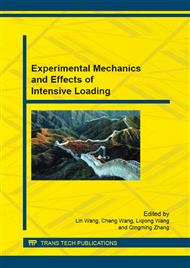p.107
p.113
p.119
p.124
p.130
p.137
p.143
p.153
p.158
Plastic Flow Stress and Constitutive Model for H96 Brass Alloy
Abstract:
To explore the thermo-mechanical response of H96 brass alloy, the quasi-static (universal-testing machine) and dynamic (the split Hopkinson pressure bar apparatus) uniaxial compression experiments have been performed under the temperatures from 293 K to 873 K and the strain rates from 0.001 s-1 to 6000 s-1, and the strains over 60% are obtained. Results show that, H96 brass alloy has strong strain hardening behavior, and it becomes weaker with the increasing temperature. In addition, this alloy is sensitive to strain rates; and, it has temperature sensitivity, the dynamic strain aging occurs at the temperature of 473 K and a quasi-static strain rate of 0.001 s-1. Based on the thermal activation dislocation mechanism, paralleled with the experimental results, a plastic flow constitutive model with the physical conception is developed. The model is suitable to predict the plastic flow stress at different temperatures and strain rates. According to comparing results, the model predictions are in good agreement with the experimental results.
Info:
Periodical:
Pages:
130-136
Citation:
Online since:
August 2015
Authors:
Price:
Сopyright:
© 2015 Trans Tech Publications Ltd. All Rights Reserved
Share:
Citation:


